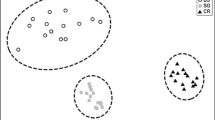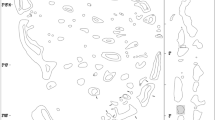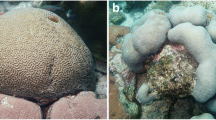Abstract
Corallivorous gastropods of the genus Drupella are known for population outbreaks throughout the Indo-Pacific region. Despite their potential to destroy wide areas of coral reef, prey preferences have never been analyzed with respect to prey availability, and juvenile ecology and food selectivity remain largely unknown. Here, the influence of water depth, coral abundance, colony shape, prey species, and intraspecific attraction among snails on distribution patterns, prey selection, and microhabitat use of D. cornus was studied in the northern Red Sea. Special emphasis was put on ontogenetic differences. The snails were most abundant in the shallowest reef zone (1 m depth). Adults were associated with several substrates and coral growth forms, whereas juveniles were highly cryptic and restricted to live branching corals. The genus Acropora was significantly preferred over other acroporid and pocilloporid corals. As revealed by resource selection ratios, Acropora acuminata was preferred by juveniles, A. selago by adults. In aquarium experiments, intraspecific attraction was high among both life stages. Overall, significant differences in juvenile and adult microhabitat and prey use suggest that juveniles have more specific habitat requirements, and indicate ecological impacts on coral communities different from that of adults. Prey preferences seem to depend on both coral genus and colony shape. Acropora corals provide the best combination of food and shelter and therefore determine distribution patterns of D. cornus.


Similar content being viewed by others
References
Al-Moghrabi, S. M., 1997. Bathymetric distribution of Drupella cornus and Coralliophila neritoidea in the Gulf of Aqaba (Jordan). In Proceedings of the 8th International Coral Reef Symposium, Vol. 2: 1345–1350.
Antonius, A. & B. Riegl, 1997. A possible link between coral diseases and a corallivorous snail (Drupella cornus) outbreak in the Red Sea. Atoll Research Bulletin 447: 1–9.
Antonius, A. & B. Riegl, 1998. Coral diseases and Drupella cornus invasion in the Red Sea. Coral Reefs 17: 48.
Berumen, M. L., M. S. Pratchett & M. I. McCormick, 2005. Within-reef differences in diet and body condition of coral-feeding butterflyfishes (Chaetodontidae). Marine Ecology Progress Series 287: 217–227.
Boucher, L. M., 1986. Coral predation by muricid gastropods of the genus Drupella at Enewetak, Marshall Islands. Bulletin of Marine Science 38: 9–11.
Bray, J. R. & J. T. Curtis, 1957. An ordination of the upland forest communities of southern Wisconsin. Ecological Monographs 27: 325–349.
Brown, K. M. & J. E. Alexander Jr., 1994. Group foraging in a marine gastropod predator: benefits and costs to individuals. Marine Ecology Progress Series 112: 97–105.
Clarke, K. R. & R. N. Gorley, 2001. Primer v5: User Manual/Tutorial. Primer-E, Plymouth.
Clarke, K. R. & R. M. Warwick, 1994. Changes in Marine Communities: An Approach to Statistical Analysis and Interpretation. Plymouth Marine Laboratory, Plymouth.
Cole, A. J., M. S. Pratchett & G. P. Jones, 2008. Diversity and functional importance of coral-feeding fishes on tropical coral reefs. Fish and Fisheries 9: 286–307.
Cumming, R. L., 1999. Predation on reef-building corals: multiscale variation in the density of three corallivorous gastropods, Drupella spp. Coral Reefs 18: 147–157.
Cumming, R. L. & D. McCorry, 1998. Corallivorous gastropods in Hong Kong. Coral Reefs 17: 178.
De’ath, G. & P. J. Moran, 1998. Factors affecting the behaviour of crown-of-thorns starfish (Acanthaster planci L.) on the Great Barrier Reef: 2: Feeding preferences. Journal of Experimental Marine Biology and Ecology 220: 107–126.
Dirnwöber, M. & J. Herler, 2007. Microhabitat specialisation and ecological consequences for coral gobies of the genus Gobiodon in the Gulf of Aqaba, northern Red Sea. Marine Ecology Progress Series 342: 265–275.
Feary, D. A., 2007. The influence of resource spezialisation on the response of reef fish to coral disturbance. Marine Biology 153: 153–161.
Forde, M. J., 1992. Population, behaviour and effects of Drupella cornus on the Ningaloo Reef, Western Australia. In Turner, S. J. (ed.), Drupella cornus: A Synopsis. Department of Conservation and Land Management, Western Australia: 45–50.
Fujioka, Y. & K. Yamazato, 1983. Host selection of some Okinawan coral associated gastropods belonging to the genera Drupella, Coralliophila and Quoyula. Galaxea 2: 59–73.
Glynn, P. W., 2001. Bioerosion and coral-reef growth: a dynamic balance. In Birkeland, C. (ed.), Life and Death of Coral Reefs. Kluwer Academic Publishers, Boston/Dordrecht/London: 536.
Glynn, P. W., M. Perez & S. L. Gilchrist, 1985. Lipid decline in stressed corals and their crustacean symbionts. Biological Bulletin 168: 276–284.
Gochfeld, D. J., 2004. Predation-induced morphological and behavioral defenses in a hard coral: implications for foraging behavior of coral-feeding butterflyfishes. Marine Ecology Progress Series 267: 145–158.
Gosselin, L. A., 1997. An ecological transition during juvenile life in a marine snail. Marine Ecology Progress Series 157: 185–194.
Hammer, O., D. A. T. Harper & P. D. Ryan, 2001. PAST: paleontological statistics software package for education and data analysis. Palaeontologica Electronica 4: 9.
Johnson, M. S., K. Holborn & R. Black, 1993. Fine-scale patchiness and genetic heterogeneity of recruits of the corallivorous gastropod Drupella cornus. Marine Biology 117: 91–96.
Keesing, J. K., 1990. Feeding biology of the crown-of-thorns starfish, Acanthaster planci (Linnaeus). PhD thesis, James Cook University of North Queensland, Townsville: 197.
Manly, B. F. J., L. L. McDonald & D. L. Thomas, 1993. Resource Selection by Animals: Statistical Design and Analysis for Field Studies. Chapman and Hall, London.
Mastaller, M., 1978. The marine molluscan assemblages of Port Sudan, Red Sea. Zoologische Mededelingen 53: 117–144.
Mastaller, M., 1979. Beiträge zur Faunistik and Ökologie der Mollusken und Echinodermen in den Korallenriffen bei Aqaba, Rotes Meer. University of Bochum, Germany.
McClanahan, T. R., 1994. Coral-eating snail Drupella cornus population increases in Kenyan coral reef lagoons. Marine Ecology Progress Series 115: 131–137.
McClanahan, T. R., 1997. Dynamics of Drupella cornus populations on Kenyan coral reefs. In Proceedings of the 8th International Coral Reef Symposium, Vol. 1: 633–638.
McClanahan, T. R., J. Maina, R. Moothien-Pillay & A. C. Baker, 2005. Effects of geography, taxa, water flow, and temperature variation on coral bleaching intensity in Mauritius. Marine Ecology Progress Series 298: 131–142.
Mergner, H. & H. Schuhmacher, 1974. Morphologie, Ökologie und Zonierung von Korallenriffen bei Aqaba (Golf von Aqaba, Rotes Meer). Helgoländer wissenschaftliche Meeresuntersuchungen 32: 238–358.
Moran, P. J., 1986. The Acanthaster phenomen. Oceanography and Marine Biology: An Annual Review 24: 379–480.
Morton, B. & G. Blackmore, 2009. Seasonal variations in the density of and corallivory by Drupella rugosa and Cronia margariticola (Caenogastropoda: Muricidae) from the coastal waters of Hong Kong: ‘plagues’ or ‘aggregations’? Journal of the Marine Biological Association of the United Kingdom 89: 147–159.
Morton, B., G. Blackmore & C. T. Kwok, 2002. Corallivory and prey choice by Drupella rugosa (Gastropoda: Muricidae) in Hong Kong. Journal of Molluscan Studies 68: 217–223.
Munday, P. L., 2000. Interactions between habitat use and patterns of abundance in coral-dwelling fishes of the genus Gobiodon. Environmental Biology of Fishes 58: 355–369.
Munday, P. L., 2004. Habitat loss, resource spezialisation, and extinction on coral reefs. Global Change Biology 10: 1642–1647.
Ott, B. & J. B. Lewis, 1972. The importance of the gastropod Coralliophila abbreviata (Lamarck) and the polychaete Hermodice carunculata (Pallas) as coral reef predators. Canadian Journal of Zoology 50: 1651–1656.
Patton, W. K., 1994. Distribution and ecology of animals associated with branching corals (Acropora spp.) from the Great Barrier Reef, Australia. Bulletin of Marine Science 55: 193–211.
Pratchett, M. S., 2007. Dietary selection by coral-feeding butterflyfishes (Chaetodontidae) on the Great Barrier Reef, Australia. The Raffles Bulletin of Zoology Supplement No. 14: 171–176.
Riegl, B. & B. Velimirov, 1994. The structure of coral communities at Hurghada in the northern Red Sea. Marine Ecology 15: 213–231.
Robertson, R., 1970. Review of the predators and parasites of stony corals, with special reference to symbiotic prosobranch gastropods. Pacific Science 24: 43–54.
Schiemer, L., M. Niedermüller & J. Herler, 2008. The influence of colony size and coral health on the occupation of coral-associated gobies (Pisces: Gobiidae). Coral Reefs. doi:10.1007/s00338-00008-00420-00335.
Schuhmacher, H., 1992. Impact of some corallivorous snails on stony corals in the Red Sea. In Proceedings of the 7th International Coral Reef Symposium, Vol. 2: 840–846.
Schuhmacher, H., W. Kiene, W. C. Dullo, M. Gektidis, S. Golubic, G. A. Heiss, H. Kampmann, D. K. Kroll, M. L. Kuhrau, G. Radtke, J. G. Reijmer, G. B. Reinicke, D. Schlichter & K. Vogel, 1995. Factors controlling Holocene reef growth—an interdisciplinary approach. Facies 32: 145–188.
Shafir, S., O. Gur & B. Rinkevich, 2008. A Drupella cornus outbreak in the northern Gulf of Eilat and changes in coral prey. Coral Reefs 27: 379.
Taylor, J. D. & D. G. Reid, 1984. The abundance and trophic classification of molluscs upon coral reefs in the Sudanese Red Sea. Journal of Natural History 18: 175–209.
Thomas, D. L. & J. D. Taylor, 1990. Study designs and tests for comparing resource use and availability. Journal of Wildlife Management 54: 322–330.
Turner, S. J., 1994a. The biology and population outbreaks of the corallivorous gastropod Drupella on Indo-Pacific reefs. Oceanography and Marine Biology: An Annual Review 32: 461–530.
Turner, S. J., 1994b. Spatial variability in the abundance of the corallivorous gastropod Drupella cornus. Coral Reefs 13: 41–48.
Vytopil, E. & B. L. Willis, 2001. Epifaunal community structure in Acropora spp. (Scleractinia) on the Great Barrier Reef: implications of coral morphology and habitat complexity. Coral Reefs 20: 281–288.
Wall, M. & J. Herler, 2009. Postsettlement movement patterns and homing in a coral-associated fish. Behavioral Ecology 20: 87–95.
Wallace, C., 1999. Staghorn Corals of the World: A Revision of the Coral Genus Acropora. CSIRO Publishing, Collingwood.
Zuschin, M. & P. G. Oliver, 2003. Fidelity of molluscan life and death assemblages on sublittoral hard substrata around granitic islands of the Seychelles. Lethaia 36: 133–150.
Zuschin, M. & M. Stachowitsch, 2007. The distribution of molluscan assemblages and their postmortem fate on coral reefs in the Gulf of Aqaba (northern Red Sea). Marine Biology 151: 2217–2230.
Zuschin, M., J. Hohenegger & F. F. Steininger, 2001. Molluscan assemblages on coral reefs and associated hard substrata in the northern Red Sea. Coral Reefs 20: 107–116.
Acknowledgments
We thank Moustafa Fouda (Nature Conservation Section of the Egyptian Environmental Affairs Agency) and Ayman Mabrouk (Nabq Managed Resource Protected Area) for research permissions, Andy Tischer and Hans Lange (both Dahab Marine Research Center, DiveIn) for logistic support. Michael Stachowitsch provided helpful comments on a former version of this article. The study was funded by a grant of the University of Innsbruck to VS. JH was supported by an APART-grant (Austrian Programme for Advanced Research and Technology) of the Austrian Academy of Sciences, and MZ by project P19013-B17 of the Austrian Science Fund (FWF).
Author information
Authors and Affiliations
Corresponding author
Additional information
Handling editor: I. Nagelkerken
Rights and permissions
About this article
Cite this article
Schoepf, V., Herler, J. & Zuschin, M. Microhabitat use and prey selection of the coral-feeding snail Drupella cornus in the northern Red Sea. Hydrobiologia 641, 45–57 (2010). https://doi.org/10.1007/s10750-009-0053-x
Received:
Revised:
Accepted:
Published:
Issue Date:
DOI: https://doi.org/10.1007/s10750-009-0053-x




